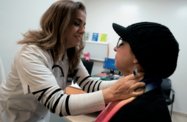Morocco: Increasing access to medication
 En Français
En Français
Morocco’s pharmaceuticals sector is negotiating a tricky balancing act at the moment, in a bid to widen access while taking into consideration worries from manufacturers and pharmacists over cost-recovery. Local production plays a significant role in satisfying domestic demand, but the market has long struggled with concerns over the prices of brand-name products, which has prompted the government to increase generic distribution and try to lower end-user prices.
The pharmaceuticals sector in Morocco is the second largest on the African continent, following South Africa. It is made up of 40 industrial units, 50 distributors, and more than 11,500 pharmacies. Local production supplies 70% of domestic demand and the country exports 10% of its production, particularly to neighbouring African nations. Still, domestic consumption is rather low, with annual spending per citizen totalling about Dh400-450 (€36-40), compared to €61 in Algeria and €98 globally.
“Consumption is €24 per person per year in Morocco and in Tunisia it is €41, a difference of 70%,” Patrice Fuster, the general manager of Sanofi Aventis, told OBG.
Part of the reason for the limited per capita consumption can be attributed to pricing, which has been a persistent concern for retail customers. In 2009, a parliamentary study found that prices for branded drugs were between 30% and 189% higher than in Tunisia and 20% to 70% more expensive than in France. Although price reductions have been imposed since then, cost remains a source of concern, particularly as the country is currently looking to boost access to medicine.
As a result, the government is hoping to conclude another round of price reductions by the end of December 2012, which if successful will serve to bring prices of all drugs down by 30 to 60%. Negotiations are currently being carried out between industry associations, pharmaceutical firms and the government to reach a compromise on how best to achieve these price reductions.
In this vein, the government has recently concluded agreements with the country’s three main pharmaceutical organisations: the Moroccan Association of Generic Medicine Producers (Association Marocaine du Médicament Générique, AMMG), the Moroccan Association of Pharmaceutical Producers (Association Marocaine de l'Industrie Pharmaceutique, AMIP), and Health Innovation Morocco (Maroc Innovation Santé, MIS), an organisation for subsidiaries of international pharmaceutical firms, which help reduce the prices on certain medicines.
However, while price reductions may spur higher consumption, private operators in both the manufacturing and distribution segments have expressed concern over their ability to recoup costs if effective compensation measures are not put in place. Pharmacists, for example, have been particularly vocal in their worries over the potential negative impacts of price reductions. From some 2500 in the 1996, there are more than 11,500 pharmacies today in Morocco. However, the current annual average turnover per pharmacy does not exceed Dh700,000 (€63,000), down from Dh2m (€180,000) in 1996.
There may be other challenges as well. “The industry has come up with proposals for reform to change the pricing structure, but for these to have any effect, other changes are necessary, for instance in how the distribution channels are organised,” Eric Reurts, the general manager of Novo Nordisk, told OBG. In the meantime, pharmacies have expressed their interest in taking part in the Medical Assistance Programme for the Economically Disadvantaged (Regime d’Assistance Médicale aux Economiquement Démunis, RAMED) through PPPs. First introduced in the Tadla-Azilal region in 2008, RAMED is expected to extend coverage to a total of 8.5m people over the next few years. The programme will help drive sales as the government looks to extend access to new medicines to participants of the RAMED programme.
Yet in spite of the challenging balance that must be struck between ensuring a profitable business environment and guaranteeing affordable access to medication – a hurdle that countries around the world face – Morocco has nonetheless emerged as one of the most attractive destinations for pharmaceutical investment over the past year.
A number of pharmaceutical firms have set up operations recently. In October 2011, Jordan-based Hikma Pharmaceuticals acquired 63.9% of Morocco’s Promopharm for $111.2m and has plans to introduce more than 20 Hikma products to the market. Then, in early 2012, in a bid to acquire the rest of Promopharm, Hikma brought its share in the firm to 94.12%.
Another new entrant is India-based Ranbaxy, a major global producer of generics. Indeed, the production of generic medicine is a rapidly growing industry, with a market share of around 30%. The firm invested some Dh20m (€1.76m) to open its first unit in Casablanca, making it the third on the continent, following South Africa and Nigeria.
The short-term and medium-term outlook for the sector is impacted in part by the challenging negotiations over pricing and access, but ultimately, the fundamentals of the Moroccan market, including a sizable population, skilled labour pool and reliable infrastructure, will help ensure that domestic production, whether in brand-name or generic products, continue to grow.



